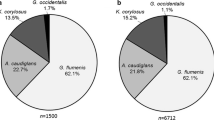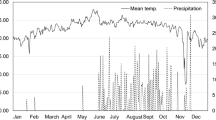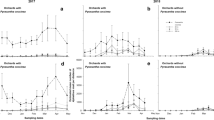Abstract
Galendromus occidentalis (Nesbitt) is an important biological control agent of spider mites (Acari: Tetranychidae) in Washington apple orchards. It was thought to be essentially the sole phytoseiid existing in this system, due in part to its resistance to commonly used orchard pesticides, and organophosphates in particular. To test this assumption, we conducted a survey of 102 commercial apple blocks in Washington to characterize the community of phytoseiid species. Seven phytoseiid species were found in our samples; G. occidentalis and Amblydromella caudiglans (Schuster) were found in the greatest abundance. We hypothesized that the gradual shift away from the use of organophosphates in recent decades may have caused the change in phytoseiid community structure. The survey data and information regarding the management, location, and surrounding habitat of each block were used to determine what factors affect phytoseiid abundances. Galendromus occidentalis abundance was positively affected by the use of conventional (vs. organic) spray programs, and the use of the acaricide bifenazate. Amblydromella caudiglans abundance was negatively affected by bifenazate use and positively affected by herbicide strip weediness; it was also less prevalent in ‘Golden Delicious’ blocks compared to other cultivars. These results indicate that A. caudiglans reaches higher abundances in orchards that lack certain agricultural disturbances, whereas G. occidentalis can survive in more disturbed environments. Surveys of this nature can provide valuable insight to potential drivers of community structure, allowing for the improvement of integrated pest management programs that incorporate conservation of newly recognized biological control agents such as A. caudiglans.





Similar content being viewed by others
References
Abad-Moyano R, Urbaneja A, Hoffmann D, Schausberger P (2010) Effect of Euseius stipulatus on establishment and efficacy in spider mite suppression of Neoseiulus californicus and Phytoseiulus persimilis in clementine. Exp Appl Acarol 50:329–341
Aguilar-Fenollosa E, Ibanez-Gual MV, Pascual-Ruiz S, Hurtado M, Jacas JA (2011) Effect of ground-cover management on spider mites and their phytoseiid natural enemies in clementine mandarin orchards (II): top–down regulation mechanisms. Biol Control 59:171–179
Alston DG (1994) Effect of apple orchard floor vegetation on density and dispersal of phytophagous and predaceous mites in Utah. Agric Ecosyst Environ 50:73–84
Barber A, Campbell CAM, Crane H, Lilley R, Tregidga E (2003) Biocontrol of two-spotted spider mite Tetranychus urticae on dwarf hops by the phytoseiid mites Phytoseiulus persimilis and Neoseiulus californicus. Biocontrol Sci. Technol. 13:275–284
Beers EH, Schmidt RA (2014) Impacts of orchard pesticides on Galendromus occidentalis: lethal and sublethal effects. Crop Prot 56:16–24
Beers EH, Brunner JF, Dunley JE, Doerr M, Granger K (2005) Role of neonicotinyl insecticides in Washington apple integrated pest management. Part II. Nontarget effects on integrated mite control. J Insect Sci 5(16):1–10
Berkett LP, Forsythe HY (1980) Predaceous mites (Acari) associated with apple foliage in Maine. Can Entomol 112:497–502
Bostanian NJ, Hardman JM, Racette G, Franklin J, Lasnier J (2006) Inventory of predacious mites in Quebec commercial apple orchards where integrated pest management programs are implemented. Ann Entomol Soc Am 99:536–544
Bostanian NJ, Thistlewood HA, Hardman JM, Laurin M-C, Racette G (2009) Effect of seven new orchard pesticides on Galendromus occidentalis in laboratory studies. Pest Manag Sci 65:635–639
Bostanian NJ, Hardman JM, Thistlewood HA, Racette G (2010) Effects of six selected orchard insecticides on Neoseiulus fallacis. Pest Manag Sci 66:1263–1267
Clements DR, Harmsen R (1990) Predatory behavior and prey-stage preferences of stigmaeid and phytoseiid mites and their potential compatibility in biological control. Can Entomol 122:321–328
Croft BA (1982) Apple pest management. In: Metcalf RL, Luckmann WH (eds) Introduction to insect pest management. Wiley-Interscience, New York, pp 465–498
Croft BA (1990) Endemic species. In: Arthropod biological control agents and pesticides. Wiley, New York, pp 431–453
Croft BA, Luh H-K (2004) Phytoseiid mites on unsprayed apple trees in Oregon, and other western states (USA): distributions, life-style types and relevance to commercial orchards. Exp Appl Acarol 33:281–326
Croft BA, MacRae IV (1992a) Biological control of apple mites by mixed populations of Metaseiulus occidentalis (Nesbitt) and Typhlodromus pyri Scheuten (Acari: Phytoseiidae). Environ Entomol 21:202–209
Croft BA, MacRae IV (1992b) Persistence of Typhlodromus pyri and Metaseiulus occidentalis (Acari: Phytoseiidae) on apple after inoculative release and competition with Zetzellia mali (Acari: Stigmaeidae). Environ Entomol 21:1168–1177
Croft BA, MacRae IV (1993) Biological control of apple mites: impact of Zetzellia mali (Acari: Stigmaeidae) on Typhlodromus pyri and Metaseiulus occidentalis (Acari: Phytoseiidae). Environ Entomol 22:865–873
Croft BA, McGroarty DL (1977) The role of Amblyseius fallacis (Acarina: Phytoseiidae) in Michigan apple orchards. Farm Sci 333:2–22
Denmark HA, Evans GA (2011) Phytoseiidae of North America and Hawaii (Acari: Mesostigmata). Indira Publishing House, West Bloomfield, MI
Downing RS, Moilliet TK (1967) Relative densities of predaceous and phytophagous mites on three varieties of apple trees. Can Entomol 99:738–741
Downing RS, Moilliet TK (1972) Replacement of Typhlodromus occidentalis by T. caudiglans and T. pyri (Acarina: Phytoseiidae) after cessation of sprays on apple trees. Can Entomol 104:937–940
Duso C, Fanti M, Pozzebon A, Angeli G (2009) Is the predatory mite Kampimodromus aberrans a candidate for the control of phytophagous mites in European apple orchards? Biocontrol 54:369–382
Duso C, Ahmad S, Tirello P, Pozzebon A, Klaric V, Baldessari M, Malagnini V, Angeli G (2014) The impact of insecticides applied in apple orchards on the predatory mite Kampimodromus aberrans (Acari: Phytoseiidae). Exp Appl Acarol 62:391–414
Environmental Protection Agency (2012) Azinphos-methyl uses cancellation 30 Sept 2012; use of existing stocks allowed through September 2013. http://www.epa.gov/oppfead1/cb/csb_page/updates/2012/azinphos-methyl.html
Environmental Protection Agency (2014) Conventional reduced risk pesticide program. Pesticide registration. http://www2.epa.gov/pesticide-registration/conventional-reduced-risk-pesticide-program
ESRI (2010) ArcGIS Desktop: Release 10. Redlands, CA
Gadino AN, Walton VM, Dreves AJ (2011) Impact of vineyard pesticides on a beneficial arthropod, Typhlodromus pyri (Acari: Phytoseiidae), in laboratory bioassays. J Econ Entomol 104:970–977
Gerson U, Smiley RL, Ochoa R (2003) The effect of host plants and the ground cover on acarine biocontrol agents. In: Mites (Acari) for pest control. Blackwell Science, Oxford, pp 332–359
Griffin JN, Byrnes JE, Cardinale BJ (2013) Predator richness and prey suppression: meta-analysis reveals importance of scale and phylogenetic diversity. Ecology 94:2180–2218
Horton DR, Broers DA, Hinojosa T, Lewis TM, Miliczky ER, Lewis RR (2002) Diversity and phenology of predatory arthropods overwintering in cardboard bands place in pear and apple orchards of central Washington State. Ann Entomol Soc Am 95:469–480
Hoy MA (2011) Integrated mite management in Washington apple orchards. In: Agricultural acarology: introduction to integrated mite management. Taylor and Francis Group, LLC, Boca Raton, FL, pp 237–242
Hoyt SC (1969) Integrated chemical control of insects and biological control of mites on apple in Washington. J Econ Entomol 62:74–86
Hoyt SC (1991) Biology, ecology and control of mites in Washington orchards. In: Williams K (ed) New directions in tree fruit pest management. Good Fruit Grower, Yakima, WA, pp 147–156
Huang M-D, Mai S-W, Li S-X, Situ J (1983) Biological control of citrus red mite, Panonychus citri (McG.) in Guangdong Province. In: Matsumoto K (ed) Proceedings, 4th international citrus congress, 9–12 Nov 1981, Tokyo, Japan. International Society of Citriculture, pp 643–646
Jones VP, Brunner JF (1993) Degree-day models. In: Beers EH, Brunner JF, Willett MJ, Warner GM (eds) Orchard pest management: a resource book for the Pacific Northwest. Good Fruit Grower, Yakima, WA
Kawashima M, Jung C (2010) Artificial ground shelters for overwintering phytoseiid mites in orchards. Exp Appl Acarol 52:35–47
Lefebvre M, Bostanian NJ, Thistlewood HMA, Mauffette Y, Racette G (2011) A laboratory assessment of the toxic attributes of six ‘reduced risk insecticides’ on Galendromus occidentalis (Acari: Phytoseiidae). Chemosphere 84:25–30
Lefebvre M, Bostanian NJ, Mauffette Y, Racette G, Thistlewood HA, Hardman JM (2012) Laboratory-based toxicological assessments of new insecticides on mortality and fecundity of Neoseiulus fallacis (Acari: Phytoseiidae). J Econ Entomol 105:866–871
Madsen HF (1964). Integrated control of phytophagous mites on apple and pear. In: Proceedings, 60th annual meeting of the Washington State Horticultural Association, 7–9 Dec 1964. Washington State Horticultural Association, Wenatchee, WA, pp 75–78
Mailloux J, Le Bellec F, Kreiter S, Tixier M-S, Dubois P (2010) Influence of ground cover management on diversity and density of phytoseiid mites (Acari: Phytoseiidae) in Guadeloupean citrus orchards. Exp Appl Acarol 52:275–290
Martinez-Rocha L, Beers EH, Dunley JE (2008) Effect of pesticides on integrated mite management in Washington State. J Entomol Soc B C 105:1–12
McMurtry JA, Croft BA (1997) Life-styles of phytoseiid mites and their roles in biological control. Annu Rev Entomol 42:291–321
McMurtry JA, de Moraes GJ, Famah Sourassou N (2013) Revision of the lifestyles of phytoseiid mites (Acari: Phytoseiidae) and implications for biological control strategies. Syst Appl Acarol 18:297–320
Motoyama N, Rock GC, Dauterman WC (1970) Organophosphorus resistance in an apple orchard population of Typhlodromus (Amblyseius) fallacis. J Econ Entomol 63:1439–1442
Oatman ER (1976) An ecological study of arthropod populations on apple in northeastern Wisconsin: phytoseiid mite species on the foliage. Environ Entomol 5:63–64
Pina T, Argolo PS, Urbaneja A, Jacas J (2012) Effect of pollen quality on the efficacy of two different life-style predatory mites against Tetranychus urticae in citrus. Biol Control 61:176–183
Prischmann DA, James DG, Wright LC, Teneyck RD, Snyder WE (2005) Effects of chlorpyrifos and sulfur on spider mites (Acari: Tetranychidae) and their natural enemies. Biol Control 33:324–334
Putman WL (1962) Life-history and behaviour of the predacious mite Typhlodromus (T.) caudiglans Schuster (Acarina: Phytoseiidae) in Ontario, with notes on the prey of related species. Can Entomol 94:163–177
Rhodes EM, Liburd OE, Kelts C, Rondon SI, Francis RR (2006) Comparison of single and combination treatments of Phytoseiulus persimilis, Neoseiulus californicus, and Acramite (bifenazate) for control of twospotted spider mites in strawberries. Exp Appl Acarol 39:213–225
SAS Institute (2014a) JMP 11.0. Cary, NC
SAS Institute (2014b) SAS/Stat User’s Guide. SAS Institute, Cary, NC
Schausberger P, Walzer A (2001) Combined versus single species release of predaceous mites: Predator–predator interactions and pest suppression. Biol Control 20:269–278
Schmidt RA (2014) Leaf structures affect predatory mites (Acari: Phytoseiidae) and biological control: a review. Exp Appl Acarol 62:1–17
Stavrinides MC, Lara JR, Mills NJ (2010) Comparative influence of temperature on development and biological control of two common vineyard pests (Acari: Tetranychidae). Biol Control 55:126–131
Straub CS, Finke DL, Snyder WE (2008) Are the conservation of natural enemy biodiversity and biological control compatible goals? Biol Control 45:225–237
Strickler K, Cushing N, Whalon M, Croft BA (1987) Mite (Acari) species composition in Michigan apple orchards. Environ Entomol 16:30–36
Takahashi M, Inoue M, Takafuji A (1998) Management of the spider-mite population in a vinylhouse vinery by releasing Phytoseiulus persimilis Athias-Henriot onto the ground cover. Jpn J Appl Entomol Zool 42:71–76
Tanigoshi LK, Hoyt SC, Croft BA (1983) Basic biology and management components for mite pests and their natural enemies. In: Croft BA, Hoyt SC (eds) Integrated management of insect pests of pome and stone fruits. Wiley, New York, pp 153–218
Thistlewood H (1991) A survey of predatory mites in Ontario apple orchards with diverse pesticide programmes. Can Entomol 123:1163–1174
US Department of Agriculture (2015) National Agriculture Statistics Service Spatial Analysis Research Section. Cropland Data Layer. Available: http://www.nass.usda.gov/research/Cropland/SARS1a.htm
Villanueva RT, Harmsen R (1998). Studies on the role of the stigmaeid predator Zetzellia mali in the acarine system of apple foliage. In: Harmsen R (ed) Proceedings, Entomological Society of Ontario, Sudbury, Ontario. Entomological Society of Ontario, pp 149–155
Villanueva R, Walgenbach JF (2005) Development, oviposition, and mortality of Neoseiulus fallacis (Acari: Phytoseiidae) in response to reduced-risk insecticides. J Econ Entomol 98:2114–2120
Waite GK (1988) Integrated control of Tetranychus urticae in strawberries in south-east Queensland. Exp Appl Acarol 5:23–32
Walter DE, Proctor HC (2004) Mites on plants. In: Mites: ecology, evolution, and behaviour. CABI Publishing, Wallingford, pp 169–197
Wearing CH, Marshall RR, Colhoun C, Attfield BA (2014) Phytophagous mites and their predators during the establishment of apple orchards under biological and integrated fruit production in Central Otago, New Zealand. N Z J Crop Hortic Sci 42:127–144
Whalon M, Korson P (2008) Tart cherry azinphos-methyl transition strategy. A report to the U.S. Environmental Protection Agency. http://epa.gov/pesticides/ppdc/azm/trans-strategy08.pdf
Acknowledgments
The authors gratefully acknowledge the expertise of Jim McMurtry for confirmation of identifications, and Bahman Shafii and Bill Price for statistical consultation. We thank the cooperating growers and orchard pest consultants who answered survey questions and allowed us to sample their orchards. We also thank technicians Kaitlin Parsons, Jordan Takasugi, David Gutierrez, Mattie Warner, Allie Carnline, Bruce Greenfield, Alix Whitener, Shayla White, Alyssa White, and Ben Peterson. This work was funded in part by grants from the Washington Tree Fruit Research Commission and the Washington State Commission on Pesticide Registration.
Author information
Authors and Affiliations
Corresponding author
Electronic supplementary material
Below is the link to the electronic supplementary material.
Rights and permissions
About this article
Cite this article
Schmidt-Jeffris, R.A., Beers, E.H. & Crowder, D.W. Phytoseiids in Washington commercial apple orchards: biodiversity and factors affecting abundance. Exp Appl Acarol 67, 21–34 (2015). https://doi.org/10.1007/s10493-015-9927-y
Received:
Accepted:
Published:
Issue Date:
DOI: https://doi.org/10.1007/s10493-015-9927-y




